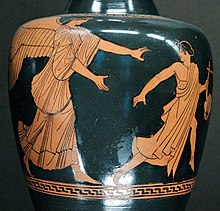Tithonus
[ii] The mythology reflected by the fifth-century vase-painters of Athens envisaged Tithonus as a rhapsode, as attested by the lyre in his hand, on an oinochoe (wine jug) of the Achilles Painter, circa 470–460 BC.[iv][v][6] Tithonus indeed lived forever, but when loathsome old age pressed full upon him, and he could not move nor lift his limbs, this seemed to her in her heart the best counsel: she laid him in a room and put to the shining doors.[9] Propertius wrote that Eos did not forsake Tithonus, old and aged as he was, and would still embrace him and hold him in her arms rather than leaving him deserted in his cold chamber, while cursing the gods for his cruel fate.[11] Sir James George Frazer notes that among ancient Greeks and several other peoples there was a widespread belief that creatures that can shed their skin renew their youth and live forever.[vii] Eos (as Thesan) and Tithonus (as Tinthu or Tinthun) provided a pictorial motif inscribed or cast in low relief on the backs of Etruscan bronze hand-mirrors.
Tithonus (disambiguation)Museum of Fine Arts, BostonLaomedon of TroyLampusHicetaonClytiusHesioneAstyocheProcliaAethillaClytodoraMemnonEmathionGreek mythologyAncient GreekromanizedLaomedonrhapsodeoinochoeAchilles Painter(6998)LouvremythemeHomeric Hymnimmortaleternal youthcicadaOlympian systemSeleneHieronymus of RhodesPropertiusJames George FrazerHesperidesDiodorus SiculusAssyriaTithonus poemSapphoThesanEtruscanThe Faerie QueeneTithonusAlfred Tennysonblank verseAuroraJohann Gottfried HerderPhillis WheatleyCumaean SibylTithonus (The X-Files)SelemnusTitansHyperionHeliosOlympiansPseudo-ApollodorusCephalusPhaethonHomeric Hymn to AphroditeAnchisesAphroditeEndymionMartin WestVatican MuseumsTzetzesLycophronOdysseySamuel ButlerLoeb Classical LibraryApollodorusThe Sydney Morning HeraldEttingerGraves, RobertWikisource1911 Encyclopædia BritannicaWayback MachineMetamorphoses in Greek mythologyAcanthisAcanthusAëdonAegoliusAegypiusAëtosAesacusAgrius and OreiusAlcanderAlcyoneAlcyone and CeyxAlcyonidesAlectryonAnthusAntigoneArne SithonisArtemicheAscalaphusAsteriaAutonousBotresCaeneusCeleusCerberusChelidonCinyrasClinisCoroneCtesyllaCycnus of AetoliaCycnus of AresCycnus of ColonaeCycnus of LiguriaDaedalionErinomaErodiusEumelusGeranaHarmothoëHarpalyceHarpasusHieraxHippodamiaHyperippeIctinusLelanteLyciusMegaletorMeleagridsMemnonidesMeropis